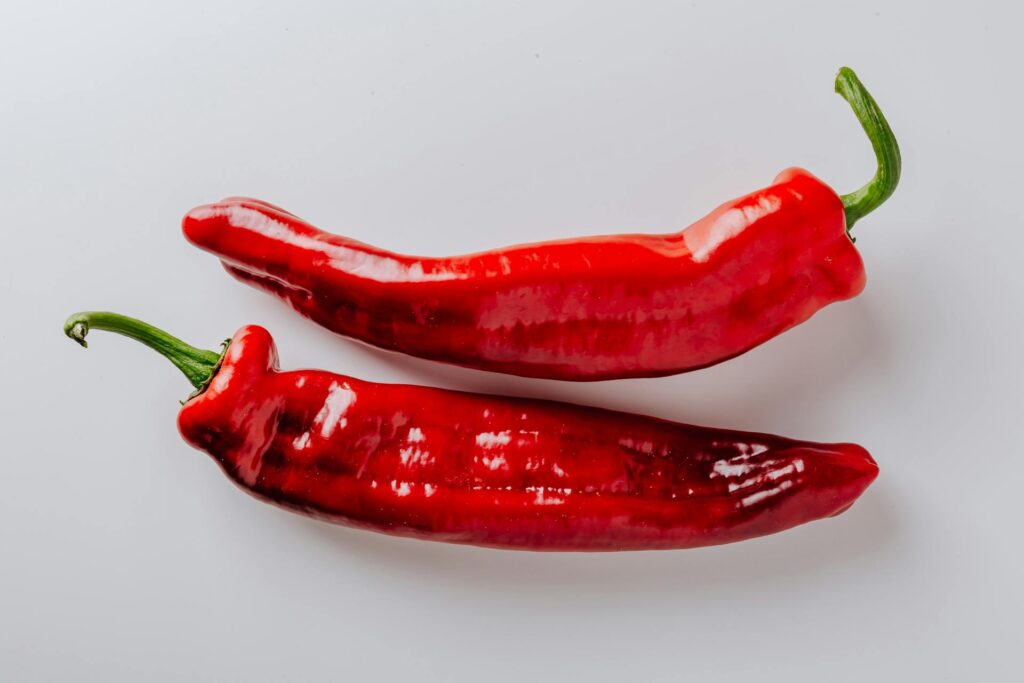
Peppers are a basic household condiment like salt but have a huge benefit to our bodies. Did you know that pepper comes from a dried unripe fruit – the peppercorn?
First off, as you know, there are different types of peppers, from the sweet bell peppers and the hot peppers and everything in between. Someone somewhere came up with the Scoville unit – which measures the heat of a given pepper. So, his name is probably Scoville. Any ways, a bell pepper has a Scoville unit (SHU) of 0 whereas a jalapeno has a unit of anywhere between 2500 and 8000. Lets take a quick look at some of the more common peppers.
- Bell Peppers (SHU 0): These sweet and crunchy peppers come in various colors and are perfect for salads, fajitas, and veggie dips.
- Shishito Peppers (SHU 50 to 100): These Japanese peppers are mild and slightly tangy. They’re often pan-fried or grilled.
- Banana Peppers (SHU 0 to 500): These elongated, yellow peppers have a mild flavor and work well in sandwiches and salads.
- Sweet Italian Pepper (SHU 100 to 500): Similar to banana peppers, these are great for stuffing or pickling.
- Piquillo Peppers (SHU 500 to 1000): These Spanish peppers are tart and slightly smoky. They’re often roasted and used in tapas.
- Cuban Pepper (SHU 1000): A lesser-known pepper with moderate heat.
- Poblano Peppers (SHU 1000 to 2000): These heart-shaped peppers are commonly used in Mexican cuisine, especially for chiles rellenos.
- Anaheim Peppers (SHU 500 to 2500): Mild and versatile, they’re great for stuffing or roasting.
- Cherry Peppers (SHU 2500 to 5000): These small, round peppers are often pickled and stuffed.
- Pasilla Peppers (SHU 1000 to 2500): Used in Mexican mole sauces, they have a rich flavor.
- Jalapeño (SHU 1000 to 8000): Familiar and moderately spicy, jalapeños are used in salsas, nachos, and more.
- Fresno Peppers (SHU 2500 to 10,000): Similar to jalapeños but hotter.
- Yellow Chili Peppers (SHU 100 to 15,000): Vibrant yellow peppers with varying heat levels.
- Serrano Peppers (SHU 10,000 to 25,000): Spicier than jalapeños, they add heat to dishes.
- Guajillo Chili Peppers (SHU 2500 to 30,000): Commonly used in Mexican cuisine, they have a fruity flavor.
- Cayenne Peppers (SHU 35,000 to 50,000): Thin-walled and spicy, often used in powdered form.
- Aleppo Pepper (SHU 30,000 to 50,000): Coarsely ground and burgundy in color, popular in Middle Eastern and Mediterranean dishes.
- Tabasco Pepper (SHU 30,000 to 50,000): Famous for Tabasco sauce.
- Scotch Bonnet (SHU 80,000 to 400,000): Looks like a hat and is common in Caribbean cuisine.
- Bird’s Eye Pepper (SHU 50,000 to 100,000): Also called Thai chili, it’s fiery hot.
- Peri-Peri Pepper (SHU 50,000 to 175,000): Also known as piri piri, it’s used in African and Portuguese cooking.
- Rocoto Pepper (SHU 50,000 to 250,000): Bell-shaped and juicy, popular in South America.
- Habanero Pepper (SHU 100,000 to 350,000): Small and bulbous, known for intense heat.
The scale continues up to Dragon’s breath SHU 2,480,000 and Pepper X (SHU 3,018,000. Shoot, and I thought jalapenos were hot…
Apart from the heat, we have the medicinal component.
- Anti-oxidant
- Anti-inflammatory
- Reduces risk of metabolic syndrome – pre-diabetes
- Reduces risk of cancer
- Fights bacterial infections that are antibiotic resistant
- Antiplatelet
- Anti-hypertensive
- Analgesic
- Anti-diarrhea
- Anti-depressant
Black pepper alone has many medicinal qualities. It has been used for over 3000 years in Ayurveda medicine and often referred to as the king of spices. Piperine is the compound attributed with many of the medicinal components
- Piperine is an anti-oxidant
- Piperine is an anti inflammatory
- Piperine is an appetite reducer
- Piperine decreases amyloid formation which are linked to dementia
- Piperine is believed to improve blood sugar metabolism and insulin sensitivity
- Piperine helps decrease LDL — misguidingly believed to be a bad cholesterol — some of the different LDLs are more important to your health than HDL AND if HDL 3a is higher than HDL 2a and 2b — you could be in trouble — a lot of misinformation was taught
- Piperine is now believed to have cancer fighting properties, especially for the triple negative breast cancer — one of the most aggressive cancers
- Piperine boosts absorption of various nutrients like calcium and selenium and turmeric
- Piperine in all peppers is believed to be a good analgesic
- Piperine is believed to increase good gut bacteria
Cayenne pepper is not only a good anti-oxidant and protects against inflammation, but it goes a step further in its ability:
- Increases vascular health and integrity — better circulation and reduction of arterial plaque
- Cayenne helps lower blood pressure
- Cayenne pepper also improves digestion
- Like other spicy foods, it helps with weight loss
- Cayenne may help relieve headaches
- Cayenne is also an analgesic
- Cayenne is also said to help clear head congestion
One thing you might want to know about black pepper is that it contains cannabinoids — just one more good reason to use lots of it.
